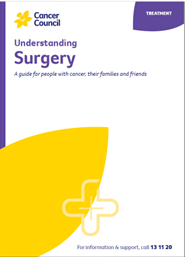- Home
- Oesophageal cancer
- Treatment
- Surgery
Surgery for oesophageal cancer
When oesophageal cancer has not spread to other organs, surgery is often recommended as long as you are well enough.
Learn more about:
- Overview
- How the surgery is done
- Oesophagectomy (surgical resection)
- Risks of oesophageal surgery
- What to expect after oesophageal surgery
- Feeding tubes
Overview
Surgery aims to remove all of the cancer while keeping as much healthy tissue as possible. The surgeon will also remove some healthy tissue around the cancer to reduce the risk of the cancer coming back in the future.
Depending on where the tumour is growing and how advanced the cancer is, you may have an endoscopic resection or an oesophagectomy.
How the surgery is done
To remove the cancer, the surgery can be done in 2 ways:
| Open surgery | The surgeon makes a large cut in the chest and the abdomen, and, sometimes, a small cut in the neck. |
| Keyhole surgery | The surgeon makes some small cuts in the abdomen and/or between the ribs, then inserts a thin instrument with a light and camera (laparoscope) into one of the cuts to see inside the body. Sometimes a small cut is made at the base of the neck on the left side. This may be used to join the oesophagus and stomach back together. |
Your surgeon will talk to you about the best type of surgery for you.
Surgery for oesophageal cancer is complex. Surgeons that regularly perform this type of surgery have better outcomes, which means that if you live far from a specialist centre, you will have to travel to have surgery. You may be eligible for help with travel costs. Call Cancer Council 13 11 20 for more information.
Oesophagectomy (surgical resection)
Surgery to remove part or all of the oesophagus is called an oesophagectomy. Nearby affected lymph nodes are also removed. It is common to have chemotherapy and/or radiation therapy before surgery, as this approach has been shown to have better results.
Depending on where in the oesophagus the cancer is, the surgeon may also remove part of the upper stomach. This is the preferred option for cancer that has spread deeper into the wall of the oesophagus or to nearby lymph nodes.
Once the parts with cancer have been removed, the stomach is pulled up and rejoined to the healthy part of the oesophagus. This will allow you to swallow and, in time, eat relatively normally. If the oesophagus cannot be rejoined to the stomach, the oesophagus will be connected to the small bowel, or a part of the bowel will be used to replace the part of the oesophagus that was removed. These procedures will help you swallow.
Risks of oesophageal surgery
As with any major surgery, oesophageal surgery has risks. These may include infection, bleeding, blood clots, damage to nearby organs, leaking from the joins between the oesophagus and stomach or small bowel, pneumonia and voice changes. Some people may have an irregular heartbeat, but this usually settles within a few days.
Surgical scars can narrow the oesophagus (called oesophageal stricture) and make it difficult to swallow. If the oesophagus becomes too narrow, your doctor may need to stretch the walls of the oesophagus (dilatation).
Your surgeon will discuss these risks with you before surgery, and you will be carefully monitored for any side effects.
→ READ MORE: What to expect after oesophageal surgery
Podcast: Making Treatment Decisions
Listen to more episodes from our podcast for people affected by cancer
Prof David I Watson, Matthew Flinders Distinguished Professor of Surgery, Flinders University, and Senior Consultant Surgeon, Oesophago-Gastric Surgery Unit, Flinders Medical Centre, SA; Prof Bryan Burmeister, Senior Radiation Oncologist, GenesisCare Fraser Coast and Hervey Bay Hospital, QLD; Kieran Cahill, Consumer; Jessica Jong, Clinical Dietitian, Upper GI and Hepatobiliary Services, Peter MacCallum Cancer Centre, VIC; John Leung, Consumer; Prof Rajvinder Singh, Professor of Medicine, University of Adelaide, and Director, Gastroenterology Department and Head of Endoscopy, Lyell McEwin Hospital, SA; Dr Sarah Sutherland, Medical Oncologist, Chris O’Brien Lifehouse, NSW; Paula Swannock, Upper GI Cancer Nurse Consultant, St Vincent’s Hospital Melbourne, VIC; Rebecca Yeoh, 13 11 20 Consultant, Cancer Council Queensland.
View the Cancer Council NSW editorial policy.
View all publications or call 13 11 20 for free printed copies.
